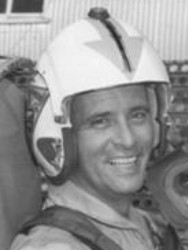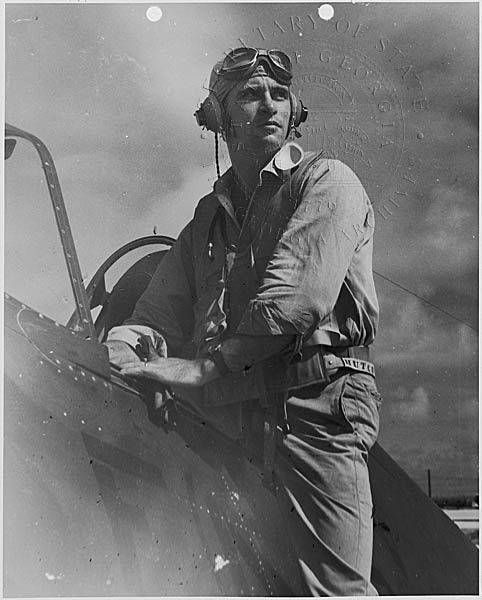WORLD WAR II, KOREA, VIETNAM
DISTINGUISHED SERVICE MEDAL
LEGION OF MERIT (2 AWARDS)
DISTINGUISHED FLYING CROSS (2 AWARDS)
AIR MEDAL (3 AWARDS)
Brig. Gen. Homer Gray Hutchinson Jr. USMC (Ret) Pioneer Marine Corps Night Fighter Pilot Homer G. "Hutch" Hutchinson Jr., 91, died Thursday, April 24, 2008, in Tallahassee, Fla., after a long struggle from the effects of Lewy Body Disease. As a Marine Corps aviator, his 30-year career spanned the era from fabric-covered biplanes to supersonic jets.
During World War II he flew night fighter-combat missions from England and in the Pacific. He later commanded the Marine Corps' first jet night-fighter squadron in the Korean conflict. Hutchinson's pioneering role in the development of aerial night-fighting was pushed by Marines being subjected to regular bombing attacks at night in the Pacific beginning in August 1942.
No American capability then existed to defeat this threat, so the Marines improvised by adopting British ground and airborne radar techniques. After undergoing rigorous instrument flight training that was essential to controlling aircraft at night and in bad weather, Hutchinson was sent to England to train and fly night combat missions with the Royal Air Force in early 1943.
On one flight over the English Channel in a Bristol Beaufighter in late April 1943, he attacked a German fighter-bomber, thus becoming one of the first Americans ever to engage in night aerial combat in a radar-equipped plane. Returning to the U.S., he trained other pilots in the complex art of night fighting and then became executive officer of Marine Night Fighter Squadron 533. When the unit deployed to the central Pacific in 1944 in Grumman Hellcats, it was to become the most successful American night fighter squadron in any conflict to date.
Because of wartime security about radar, it has been little noted that Marines became America's most successful night fighter force in both the Second World War and Korea. In 1952, Hutchinson took command of Marine Night Fighter Squadron 513 in Korea as the unit was being equipped with the nation's first purpose-built jet night fighter, the Douglas Skyknight.
In addition to supporting Marines on the ground, the unit was ordered to protect Air Force bombers on long-range missions. In history's first night jet-to-jet combats, Hutchinson's Marines shot down a half dozen enemy Migs over North Korea. No Air Force aircraft was ever lost while being escorted by Marine night fighters.
That success aside, combat-experienced leaders like Hutchinson were committed to the idea of protecting and supporting Marines on the ground. It was from this depth of experience that came present-day Marine aviation's envied ability to operate at night and in adverse weather as part of an expeditionary combined arms air-ground team.
Homer Gray Hutchinson Jr. was born April 14, 1917, in Gay, Ga., to Homer G. Hutchinson and Amelia Foskett. Raised in nearby Senoia, he graduated from the Georgia Institute of Technology as a mechanical engineer in 1939. Following a long-held desire to fly, he entered naval flight training at Pensacola as a cadet.
Winning his aviator wings in 1940, he was commissioned into the Marine Corps. In February of 1942 shortly after the United States entered the war, he married Mary Emily Parker of Tallahassee, a teacher and daughter of Milton and Omeara Parker. Rapid promotions came during the war and, after returning from the Pacific in 1945, he was a 28-year old lieutenant colonel commanding a large night-fighter training unit at Vero Beach in Florida.
Post-war assignments included command of a Vought Corsair squadron on Midway Island. Many of his staff assignments involved improving the Corps' ability to conduct both defensive and offensive all-weather air combat in an arena that included the potential of nuclear warfare. As a colonel in the 1950s, he commanded Marine Corps Air Station Kaneohe in Hawaii and Marine Aircraft Group 24 at Cherry Point in North Carolina.
During that time, he qualified on aircraft carriers in the Marines' first all-weather supersonic jet, the Douglas Skyray. He also carried out the first trans-Atlantic flight of the single-engine Douglas Skyhawk using "buddy" aerial refueling techniques. Promoted to brigadier general in 1965, Hutchinson served as Assistant Chief of Staff J-3 for the Commander in Chief, Pacific in Hawaii at the peak of the Vietnam conflict.
His last assignment was as Deputy Director, Plans J-5, U.S. Strike Command, now Central Command. In addition to his service awards, General Hutchinson's personal decorations included the Distinguished Service Medal, two Legions of Merit, two Distinguished Flying Crosses, three Air Medals and the Navy Commendation Medal.
He was awarded a master's degree in international relations by George Washington University in 1964. Following his military retirement, General Hutchinson and his wife settled in Tallahassee in 1970. During the fuel crises in the early 1970s, he served as the State of Florida's Energy Director. As "energy czar," he carried out reforms to ensure the rational uses of the state's vehicle and aircraft fleets, which up to then had been subject to few controls.
He later was a senior manager with McKenzie Tank Lines at its headquarters in Tallahassee. An avid rose grower, he was a leader in the restoration of the 19th-century rose garden at the Goodwood Museum and Gardens in the early 1990s. As the effort to restore the historic landmark got underway in 1996, he served as the first chairman of the museum's board.
Widowed in 1997, General Hutchinson married Evelyn O'Brien in 1998. In addition to his wife, General Hutchinson is survived by his daughter, Ann Hutchinson Quilter, and four grandchildren, Shannon Hutchinson, Brent Hutchinson, Emily Quilter, and C.J. Quilter III. His son, Lieutenant Colonel H. Gray Hutchinson USMC (Ret), was killed during a military training flight off the coast of Pensacola in 2002.
WORLD WAR II, KOREA, VIETNAM
DISTINGUISHED SERVICE MEDAL
LEGION OF MERIT (2 AWARDS)
DISTINGUISHED FLYING CROSS (2 AWARDS)
AIR MEDAL (3 AWARDS)
Brig. Gen. Homer Gray Hutchinson Jr. USMC (Ret) Pioneer Marine Corps Night Fighter Pilot Homer G. "Hutch" Hutchinson Jr., 91, died Thursday, April 24, 2008, in Tallahassee, Fla., after a long struggle from the effects of Lewy Body Disease. As a Marine Corps aviator, his 30-year career spanned the era from fabric-covered biplanes to supersonic jets.
During World War II he flew night fighter-combat missions from England and in the Pacific. He later commanded the Marine Corps' first jet night-fighter squadron in the Korean conflict. Hutchinson's pioneering role in the development of aerial night-fighting was pushed by Marines being subjected to regular bombing attacks at night in the Pacific beginning in August 1942.
No American capability then existed to defeat this threat, so the Marines improvised by adopting British ground and airborne radar techniques. After undergoing rigorous instrument flight training that was essential to controlling aircraft at night and in bad weather, Hutchinson was sent to England to train and fly night combat missions with the Royal Air Force in early 1943.
On one flight over the English Channel in a Bristol Beaufighter in late April 1943, he attacked a German fighter-bomber, thus becoming one of the first Americans ever to engage in night aerial combat in a radar-equipped plane. Returning to the U.S., he trained other pilots in the complex art of night fighting and then became executive officer of Marine Night Fighter Squadron 533. When the unit deployed to the central Pacific in 1944 in Grumman Hellcats, it was to become the most successful American night fighter squadron in any conflict to date.
Because of wartime security about radar, it has been little noted that Marines became America's most successful night fighter force in both the Second World War and Korea. In 1952, Hutchinson took command of Marine Night Fighter Squadron 513 in Korea as the unit was being equipped with the nation's first purpose-built jet night fighter, the Douglas Skyknight.
In addition to supporting Marines on the ground, the unit was ordered to protect Air Force bombers on long-range missions. In history's first night jet-to-jet combats, Hutchinson's Marines shot down a half dozen enemy Migs over North Korea. No Air Force aircraft was ever lost while being escorted by Marine night fighters.
That success aside, combat-experienced leaders like Hutchinson were committed to the idea of protecting and supporting Marines on the ground. It was from this depth of experience that came present-day Marine aviation's envied ability to operate at night and in adverse weather as part of an expeditionary combined arms air-ground team.
Homer Gray Hutchinson Jr. was born April 14, 1917, in Gay, Ga., to Homer G. Hutchinson and Amelia Foskett. Raised in nearby Senoia, he graduated from the Georgia Institute of Technology as a mechanical engineer in 1939. Following a long-held desire to fly, he entered naval flight training at Pensacola as a cadet.
Winning his aviator wings in 1940, he was commissioned into the Marine Corps. In February of 1942 shortly after the United States entered the war, he married Mary Emily Parker of Tallahassee, a teacher and daughter of Milton and Omeara Parker. Rapid promotions came during the war and, after returning from the Pacific in 1945, he was a 28-year old lieutenant colonel commanding a large night-fighter training unit at Vero Beach in Florida.
Post-war assignments included command of a Vought Corsair squadron on Midway Island. Many of his staff assignments involved improving the Corps' ability to conduct both defensive and offensive all-weather air combat in an arena that included the potential of nuclear warfare. As a colonel in the 1950s, he commanded Marine Corps Air Station Kaneohe in Hawaii and Marine Aircraft Group 24 at Cherry Point in North Carolina.
During that time, he qualified on aircraft carriers in the Marines' first all-weather supersonic jet, the Douglas Skyray. He also carried out the first trans-Atlantic flight of the single-engine Douglas Skyhawk using "buddy" aerial refueling techniques. Promoted to brigadier general in 1965, Hutchinson served as Assistant Chief of Staff J-3 for the Commander in Chief, Pacific in Hawaii at the peak of the Vietnam conflict.
His last assignment was as Deputy Director, Plans J-5, U.S. Strike Command, now Central Command. In addition to his service awards, General Hutchinson's personal decorations included the Distinguished Service Medal, two Legions of Merit, two Distinguished Flying Crosses, three Air Medals and the Navy Commendation Medal.
He was awarded a master's degree in international relations by George Washington University in 1964. Following his military retirement, General Hutchinson and his wife settled in Tallahassee in 1970. During the fuel crises in the early 1970s, he served as the State of Florida's Energy Director. As "energy czar," he carried out reforms to ensure the rational uses of the state's vehicle and aircraft fleets, which up to then had been subject to few controls.
He later was a senior manager with McKenzie Tank Lines at its headquarters in Tallahassee. An avid rose grower, he was a leader in the restoration of the 19th-century rose garden at the Goodwood Museum and Gardens in the early 1990s. As the effort to restore the historic landmark got underway in 1996, he served as the first chairman of the museum's board.
Widowed in 1997, General Hutchinson married Evelyn O'Brien in 1998. In addition to his wife, General Hutchinson is survived by his daughter, Ann Hutchinson Quilter, and four grandchildren, Shannon Hutchinson, Brent Hutchinson, Emily Quilter, and C.J. Quilter III. His son, Lieutenant Colonel H. Gray Hutchinson USMC (Ret), was killed during a military training flight off the coast of Pensacola in 2002.
Family Members
Sponsored by Ancestry
Advertisement
Advertisement















